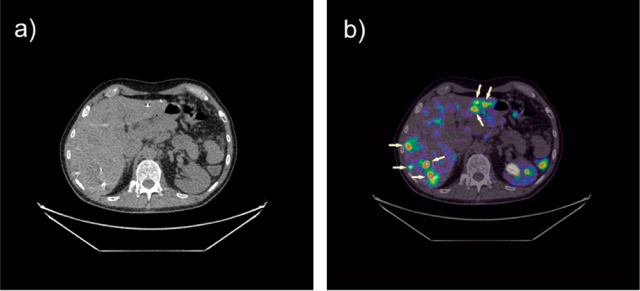New perspectives in the treatment of difficult-to-diagnose neoplasms
31-01-2022
Long-term research on radiopharmaceuticals targeting certain types of cancer, including medullary thyroid carcinoma that is difficult to diagnose and treat, has finally brought promising results in the preclinical phase. The obtained results give hope for the development of cancer theranostics. Scientists from the POLATOM Radioisotope Center at the National Center for Nuclear Research are also working on this.
Cholecystokinin-2 (CCK2R) receptors are capable of binding peptide hormones such as cholecystokinin (CCK) and gastrin. Moreover, an increased frequency of these receptors is observed in some cancer cells, e. g. medullary thyroid carcinoma. Therefore, for more than two decades, CCK2R receptors have been the focus of scientists designing drugs for molecular imaging. However, treatment targeting CCK2R has still not been established in clinical practice.
An international group of experts in the field of nuclear medicine and radiopharmaceuticals, including the POLATOM Radioisotope Center of the National Center for Nuclear Research, summarized their own experiences and the experiences of other groups of scientists in development research on new CCK2R-targeted radiopharmaceuticals and in clinical trials with their use. Scientists report that the latest clinical studies have shown the potential of radiolabelled gastrin analogues in both applications – both in imaging, i. e. in the detection and localization of neoplastic lesions, and in targeted internal radiotherapy. The concept of teranostics is confirmed here – the use of a leading molecule aimed at a biological target for diagnosis or therapy, depending on the physical characteristics of the attached radioactive isotope. The results of the first clinical trials indicate the possibility of a wider use of radiopharmaceuticals targeting CCK2R.
Overexpression, i. e. the increased incidence of CCK2R receptors in cancer cells of Medullary Thyroid Carcinoma (MTC) or in other neoplasms compared to healthy cells, makes radiopharmaceuticals targeting this receptor effective in imaging and targeted therapy oncological diseases. Patients with MTC who have metastatic neoplastic disease are in a particularly difficult situation because the currently available treatments for them are very limited.
„In recent years, preclinical studies of a number of peptide gastrin analogs targeting CCK2R have been conducted,” says Professor Renata Mikołajczak from the POLATOM NCBJ Radioisotope Center. „Only a few of them have entered the clinical trial phase. These include compounds labeled with indium-111 ([111In] In-CP04) for SPECT imaging (Single Photon Emission Computed Tomography), galem-68 ([68Ga] Ga-DOTA-MGS5) for imaging in the technique PET (Positron Emission Tomography) and Lutetium-177 ([177Lu] Lu-PP-F11N) for Peptide Receptor Radionuclide Therapy (PRRT). In the first patients to whom the new radiotracers were used, neoplastic changes that were not visible in classic computed tomography or magnetic resonance imaging were visualized. The intensive accumulation of radiopharmaceuticals in neoplastic lesions raises particular hopes related to the use of PRRT, as the new gastrin analogs are characterized by metabolic stability, high accumulation in neoplastic lesions and low toxicity to the kidneys and can be safely used in the treatment of cancer. "
Scientists announce further innovative research and further attempts to increase the diagnostic effectiveness of drugs targeting CCK2R. They will use the latest scientific achievements, modifications of molecules through organic synthesis and design using computational methods, as well as by introducing new radioactive isotopes with physical radiation characteristics better suited to the individual course of the disease. This will lead to personalization of the treatment. The implementation of such directions of research is the guiding principle of the CERAD and NOMATEN projects currently carried out at NCBJ, which expand the infrastructure and human resources potential of NCBJ.
Image (in transverse orientation) of computed tomography (a) and combination of the computed tomograph and single photon emission tomograph (b) of a patient with medullary thyroid carcinoma, with gallium-68 marking. Pictures were taken 4 hours after administration of a lower dose of peptide than in the case of indium labeling. Arrows indicate tumor metastases in the liver. The photo was taken at the Collegium Medicum of the Jagiellonian University. The owner of the photo is MDPI, Basel, Switzerland; published under the Creative Commons Attribution (CC BY) license.
The researchers’ report, entitled „Update on Preclinical Development and Clinical Translation of Cholecystokinin-2 Receptor Targeting Radiopharmaceuticals,” was published in the Cancers journal:





